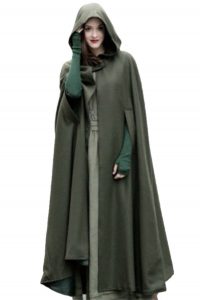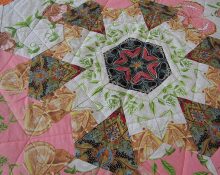
creativecommons.org
The medieval cloak is one of the most versatile carnival costumes that will suit both boys and girls. With the help of additional accessories you can radically change your looks. In this material we will tell you the history of the medieval cloak, and also provide a pattern and step-by-step plan for sewing this unusual item of clothing. At the end of the article you will find photographs of raincoats, sewing tips, and patterns.
History of the cloak: from cavemen to the Middle Ages
Raincoats were probably the very first items of clothing for people. The prototypes of cloaks were processed animal skins, which primitive people threw over their shoulders. This item of clothing has become a must-have in a man's wardrobe. Fur skins were secured with straps and pinned to one shoulder.
Later, the skins were replaced with pieces of fabric made from different materials, which changed depending on weather conditions.There are analogues of raincoats in almost all countries of the world. So, the ancient Romans wore cloaks over their tunics. Cloaks covered only one shoulder so that the color of the toga could be seen, by which the social status of the owner of the cloak could be determined. Later, with the development of dyes, social status could be determined by the cloak: red was worn by military leaders, and white by senators and high officials. The main purpose of the raincoat was protection from rain and cold. Often Roman soldiers had to sleep under their cloaks, using them as a blanket. Cloaks were worn not only in Europe, but also in the East - Arabian burnouses protected their owners from cold nights in the desert. According to one version, that same textbook wide cloak came to Europe precisely from the Arabs around the 11th century during the Crusades. According to other sources, the Vikings introduced the Europeans to cloaks, which is indirectly confirmed by the descriptions of clothing in the Icelandic sagas.
The English name for the cloak comes from the French word cloche, which means “bell.” The fact is that in the Middle Ages, cloaks were sewn in a flared shape in imitation of a bell. Most often it was a wide cloak without a fastener and looked like a large piece of fabric with a hole for the head. Only wealthy people could afford a long cloak: nobility and representatives of wealthy orders wore cloak-mantles that reached to their heels. It was not only a matter of demonstrating wealth and protection from the cold: the long tails of the cloak protected the riders from dirt and could hide their faces from prying eyes.
Hooded cloaks were popular among all segments of the population until the 14th century. Later, these clothes were used exclusively during travel.Perhaps this dramatic change in fashion is responsible for the fact that today the cloak is associated mainly with the Middle Ages. After the 14th century, cloaks with hoods were worn mainly by poor people or robbers.
Revival of fashion for medieval cloaks

creativecommons.org
However, in the middle of the 16th century, the fashion for raincoats returned thanks to Spain: local fashionistas began to diversify men's wardrobes by introducing different variations of raincoats with different lengths and cuts, the presence or absence of a collar and detachable sleeves.
The medieval version of the cloak was modified: if previously the cloak could only be worn on one shoulder (which was inconvenient for left-handers), then the modernized Spanish version could be thrown over both shoulders and draped beautifully, wrapped around the body. Nobles and wealthy fashionistas used expensive heavy fabrics to sew cloaks, and the cloak itself was complemented by a lining, which usually contrasted with the outer part of the cloak. The richest brought cloaks to embroiderers so that they could decorate the collars and edges with luxurious embroidery. Few people dared to travel in such a cloak, but city residents willingly wore it to social events and meetings. Soon the Spanish fashion for wearing raincoats spread throughout Europe. Despite the simple cut of the cloak, Europeans found something to distinguish themselves from: almost every country had its own special way of tying a cloak and its own type of specific brooch for fastening, the so-called brooches. The cut of the cloak was also different: it could be rectangular, semicircular or trapezoidal. But the color scheme for all was approximately the same; dark shades of red, blue, brown and green predominated.
The fashion of wearing a cloak on one shoulder turned out to be very opportune, because behind the cloak it was very convenient to hide a sword or any other weapon. Fencing books of that time even discussed special techniques for using a cloak during a duel. For example, one of these books suggested wrapping a cloak around your left hand (if the duelist is right-handed) and intercepting the attacker’s sword in order to strike first. Guardsmen and mercenaries began to increasingly wear cloaks, for whom this item of men's clothing acquired additional combat and camouflage functions. Oddly enough, the fashion for raincoats was stopped by the French Revolution, which not only greatly changed the political map of Europe, but also influenced the fashion of that time: raincoats replaced uniforms.
What is needed to create a medieval cloak
Material consumption largely depends on the height of the person who will wear the raincoat, and the choice of fabric depends on the final goal. For cosplay, it is better to give preference to natural fabrics for external decoration: this way, even if you get wet in the forest during games, you will be less likely to freeze. And for a performance held indoors, you can choose any fabric that imitates natural fabric.
- Large piece of fabric for outer and inner parts. You can choose contrasting colors to make it look impressive. If the raincoat will be used outdoors as a lower lining, we recommend taking a raincoat fabric. For the outside, a low-budget but warm solution would be natural wool fabric. But keep in mind that in high humidity the fabric will shrink a lot, we recommend taking this into account when cutting.
- Pattern of cloak and hood tailored to the model.
- Sewing supplies.
- Fibula, lacing or any other fastener.
Step-by-step plan for sewing a medieval cloak with a hood
The universal width of the fabric is approximately 1.5 meters. The volume of the fabric is calculated using the formula: fabric width x 2 + shoulder width. That is, on average, for one raincoat you will need about 3.5 meters of each fabric.
- Attach the patterns already fitted to the model to the fabric and to the raincoat fabric.
- Leave a margin of 1.5 cm.
- Cut out the resulting parts. You should have: the outer part of the cloak, the inner part of the cloak and the hood.
- Fold the lining and outer part of the raincoat under and connect the two parts.
- Separately process the hood and sew it to the cloak.
- Attach the fabula or any other fastener.


 0
0





